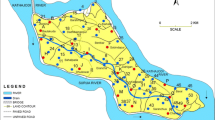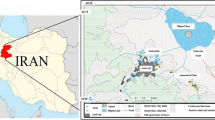Abstract
Groundwater level forecasting plays an important role in water resources management. Artificial neural network have been used as a robust instrument for this subject. In this paper, four architectures of different neural networks were used for groundwater level prediction in Shiraz Plain and their results were compared by using the statistical measures of mean square error and square of correlation coefficient. Effective parameters on groundwater level such as 5-month precipitation and groundwater level histories, temperature or evaporation, and runoff were utilized as the input data to forecast groundwater level at the next time step as output of the networks. All networks were trained for a ten-year period of data (from 1993 to 2003) and calibrated for an 18-month period (from Apr. 2003 to Sep. 2004). Networks were verified based on groundwater level observations in 29 wells located in the plain for another 18-month period (from Oct. 2004 to Mar. 2006). Results showed that artificial neural networks may be successfully utilized to forecast groundwater levels. Different networks forecasted groundwater level in all wells with acceptable root mean square errors of 0.6–12.17 m. Best overall performance was achieved by feed-forward neural network and the second best by Elman neural network.

Similar content being viewed by others
References
Chow V.T., Maidment D.R., Mays L.W.: Applied Hydrology. McGraw-Hill, Singapore (1988)
French M.N., Krajewski W.F., Cuykendall R.R.: Rainfall forecasting in space and time using a neural network. J. Hydrol. 137, 1–31 (1992)
Govindaraju, R.S.; Rao, R.A.: Artificial Neural Networks in Hydrology, p. 237. Kluwer, the Netherlands (2000)
ASCE Task Committee on Application of Artificial Neural Networks in Hydrology: Artificial neural networks in hydrology, parts I and II. ASCE J. Hydrol. Eng. 5(2), 115–137 (2000)
Coulibaly P., Anctil F., Aravena R., Bobe’e B.: Artificial neural network modeling of water table depth fluctuations. ASCE Water Resour. Res. 37(4), 885–896 (2001)
Kin L.C., Ball J.E., Sharma A.: An application of artificial neural networks for rainfall forecasting. Math. Comput. Model. 33, 683–693 (2001)
Parkin, G.; Younger, P.L.; Birkinshaw, S.J.; Murray, M.; Rao, Z.: A new approach to modeling river–aquifer interactions using a 3-D numerical model and neural networks, impact of human activity on groundwater dynamics. In: Proceedings of a Symposium held during the Sixth IAHS Scientific Assembly at Maastricht, The Netherlands, IAHS Publication, No. 269 (2001)
Grubert J.P.: Application of neural networks in stratified flow stability analysis. ASCE J. Hydraul. Eng. 121(7), 523–532 (1995)
Arndt O., Barth T., Freisleben B., Grauer M.: Approximating a finite element model by neural network prediction for facility optimization in groundwater engineering. Eur. J. Oper. Res. 166, 769–781 (2005)
Chen J., Adams B.J.: Integration of artificial neural networks with conceptual models in rainfall–runoff modeling. J. Hydrol. 318, 232–249 (2006)
Parkin G., Birkinshaw S.J., Younger P.L., Rao Z., Kirk S.: A numerical modeling and neural network approach to estimate the impact of groundwater abstractions on river flows. J. Hydrol. 339, 15–28 (2007)
Tabach E.E., Lancelot L., Shahrour I., Najjar Y.: Use of artificial neural network simulation metamodelling to assess groundwater contamination in a road project. Math. Comput. Model. 45, 766–776 (2007)
Noruzi K., Rakhshandehroo G.R.: Most probable pollution source identification in rivers by neural networks. Iran. J. Sci. Technol. 31(B5), 501–508 (2007)
Yoon H., Hyun Y., Lee K.K.: Forecasting solute breakthrough curves through the unsaturated zone using artificial neural networks. J. Hydrol. 335, 68–77 (2007)
Selle B., Lischeid G., Huwe B.: Effective modeling of percolation at the landscape scale using data-based approaches. Comput. Geosci. 34, 699–713 (2008)
Yang, Z. P.; Lu, W.X.; Long, Y.Q.; Li, P.: Application and comparison of two prediction models for groundwater levels: A case study in Western Jilin Province, China. J. Arid Environ. (2009). doi:10.1016/j.jaridenv.2008
Coulibaly P., Anctil F., Bobe’e B.: Daily reservoir inflow forecasting using artificial neural networks with stopped training approach. J. Hydrol. 230, 244–257 (2000)
Daliakopoulos, I.N.; Coulibaly, P.; Tsanis, I.K.: Groundwater level forecasting using artificial neural networks. J. Hydrol. 229–240 (2005)
Sahoo G.B., Ray C., Mehnert E., Keefer D.A.: Application of artificial neural networks to assess pesticide contamination in shallow groundwater. Sci. Total Environ. 367, 234–251 (2006)
Beaudeau P., Leboulanger T., Lacroix M., Hanneton S., Wang H.Q.: Forecasting of turbid floods in a karstic drain using an artificial neural network. Ground Water 39(1), 109–119 (2001)
Lallahem S., Mania J.: Evaluation and forecasting of daily groundwater inflow in a small chalky watershed. Hydrol. Process. 17, 1557–1561 (2003)
Lallahem S., Mania J.: A non-linear rainfall-runoff model using neural ematical network technique: example in fractured porous media. J. Math. Comput. Model. 37, 1047–1061 (2003)
Singh R. M.: Identification of unknown groundwater pollution sources using artificial neural networks. J. Water Resour. Plan. Manag. 130(6), 506–514 (2004)
Lallahem S., Mania J., Hani A., Najjar Y.: On the use of neural networks to evaluate groundwater levels in fractured media. J. Hydrol. 307, 92–111 (2005)
Kohonen T.: An introduction to neural computing. Neural Netw. 1(1), 3–16 (1988)
Hagan M.T., Demuth H.B., Beale M.: Neural Network Design. PWS, Boston (1996)
Rumelhart D.E., McClelland J.L.: Parallel distributed processing. MIT Press, Cambridge MA (1989)
Demuth, H.; Beale, M.: Neural network toolbox for use with MATLAB. Mathworks Inc; p. 158 (1994)
Elman, J. L.: Finding structure in time. Cogn. Sci. (14), 179–211 (1990)
Specht D.F.: A general regression neural network. IEEE Trans. Neural Netw. 2(6), 568–576 (1991)
Tsoukalas L.H., Uhrig R.E.: Fuzzy and neural approached in engineering. Wiley, New York (1997)
Kim B., Kim S., Kim K.: Modelling of plasma etching using a generalized regression neural network. Vacuum 71, 497–503 (2003)
Rasoulzadeh A., Moosavi A.A.: Study of groundwater recharge in the vicinity of Tashk lake area. Iran. J. Sci. Technol. 31(B5), 509–521 (2007)
Author information
Authors and Affiliations
Corresponding author
Rights and permissions
About this article
Cite this article
Rakhshandehroo, G.R., Vaghefi, M. & Aghbolaghi, M.A. Forecasting Groundwater Level in Shiraz Plain Using Artificial Neural Networks. Arab J Sci Eng 37, 1871–1883 (2012). https://doi.org/10.1007/s13369-012-0291-5
Received:
Accepted:
Published:
Issue Date:
DOI: https://doi.org/10.1007/s13369-012-0291-5




